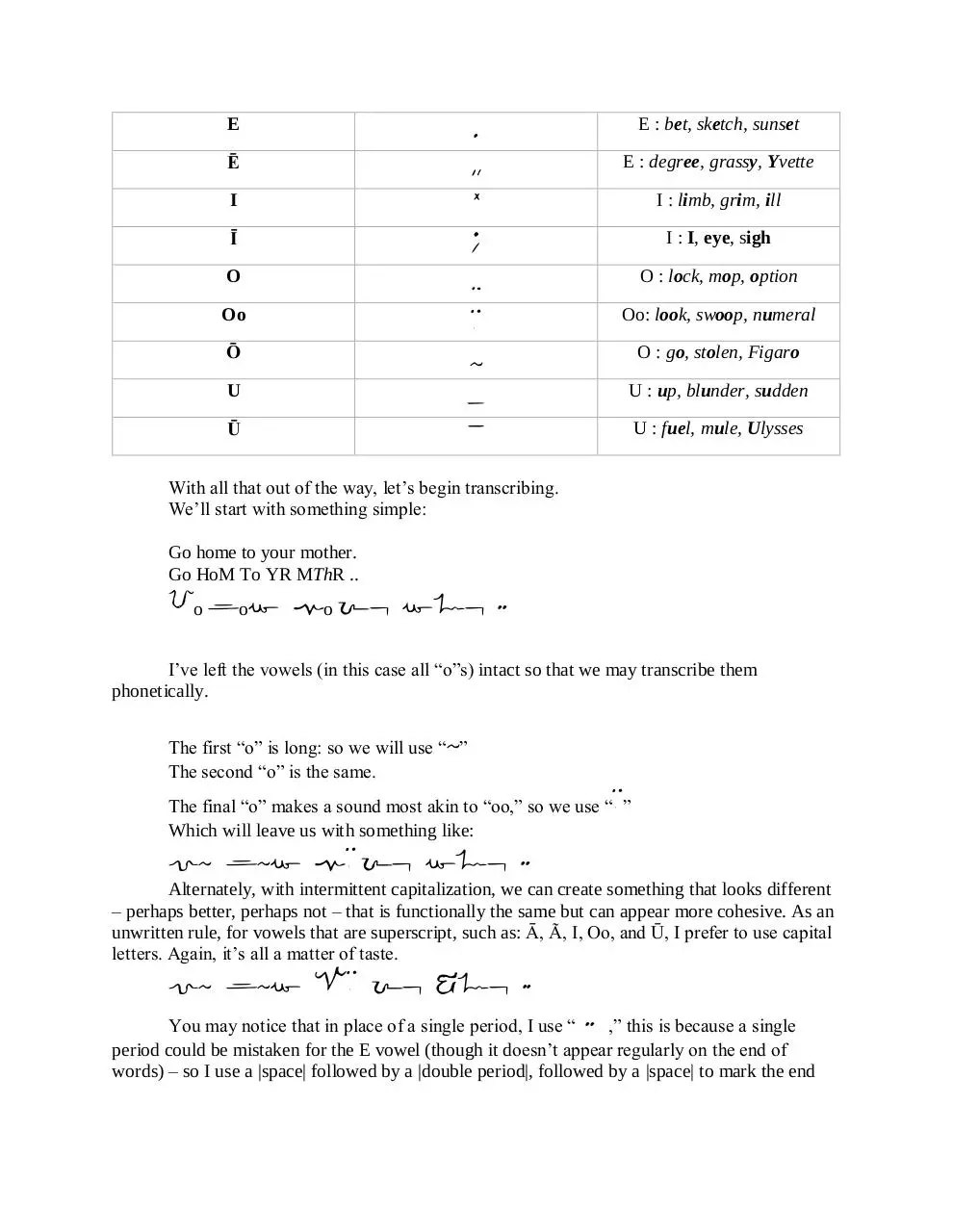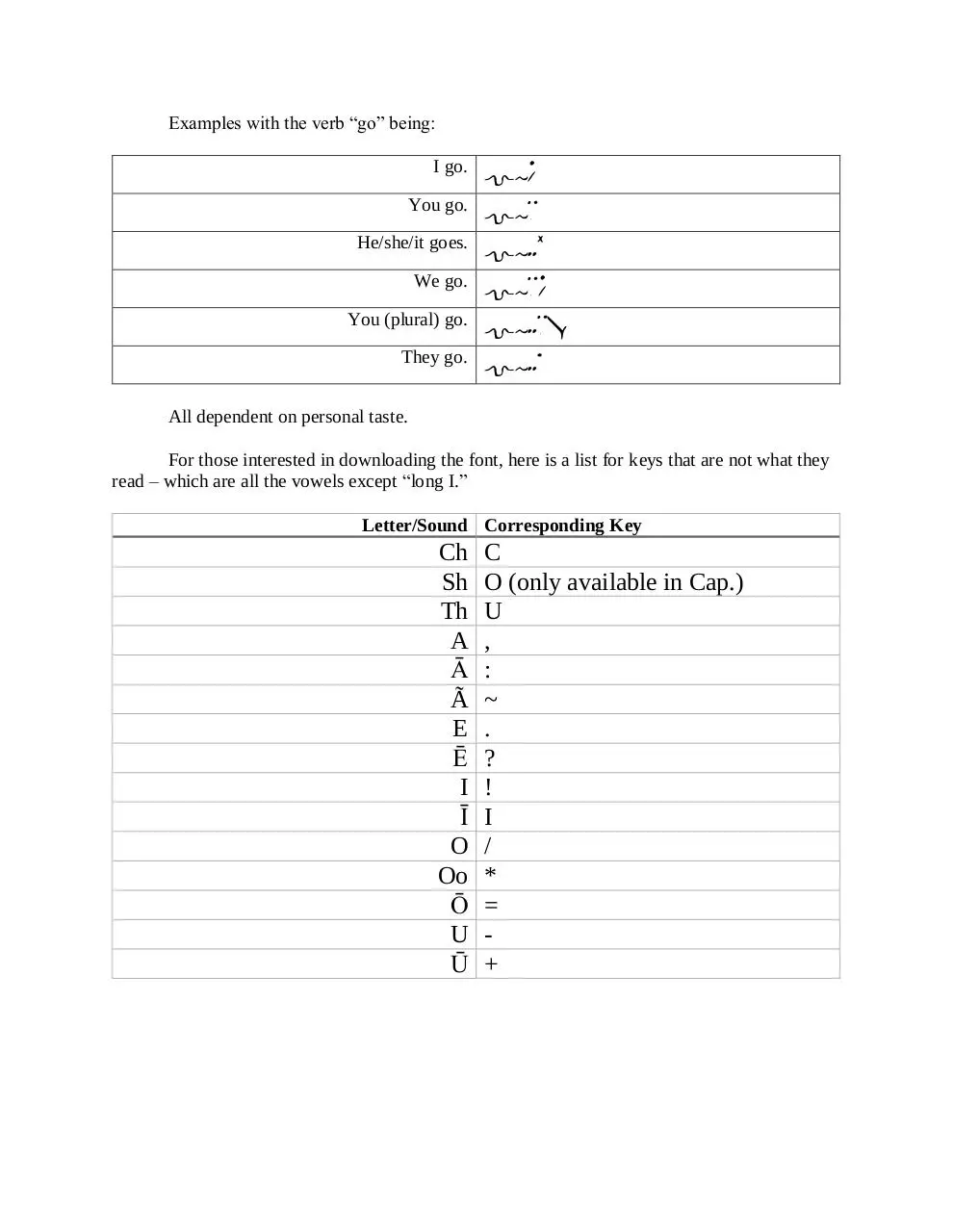Using Qedavian Script (PDF)
File information
Author: Kaje Questelle
This PDF 1.5 document has been generated by Microsoft® Word 2013, and has been sent on pdf-archive.com on 18/08/2015 at 08:13, from IP address 173.22.x.x.
The current document download page has been viewed 3212 times.
File size: 343.63 KB (5 pages).
Privacy: public file





File preview
Using Qedavian Script
.. +SNG QDV?n skrpt ..
Searching online will produce any number of “witches’” alphabets – but more accurately,
they’re simply recycled, dead languages (such as Theban and Futhark). This, however, is a
“language” (more a script, really) that I – as a witch – have created: thereby a true witches’
alphabet. And now, I’ve chosen to make it available to you in a (hopefully) handy tutorial.
Beginning with the basics.
The alphabet is one I created, but is phonetic and can be used with most any language
that utilizes the familiar Latin script and pronunciation. Below I’ve made available each
character in capitol and lowercase form – however, I do not use the same formula for
capitalization (i.e. at the beginning of a sentence or proper noun) that English uses, instead they
are used as alternates to make things more aesthetically pleasing and (if written) flow more
properly from letter to letter.
It’s also important to note that I’ve taken a few ideas from Hebrew and Arabic in that the
script is mostly consonant based, dropping vowels completely or using them only when at the
beginning or ends of words or are necessary (not implied) for pronunciation. As for the font I’ve
created to be used on the computer (which hopefully I’ll be able to make accessible) utilize
symbol keys to make vowels, not the vowel keys themselves. The reason for this being that (as
earlier mentioned) this script is phonetic – for instance, the “a” in “all” and “hate” are not
pronounced the same and require two, unique symbols.
Hopefully this will become clear.
Latin Character
Qedavian
Pronunciation
B, b
B, b
C, c
D, d
F, f
G, g
H, h
J, j
K, k
L, l
B : ball, laboratory, stab
C, c
D, d
F, f
G, g
H, h
J, j
K, k
L, l
Ch : chime, lynch, ratchet
D : dome, lord, ladle
F : fake, loft, gulf
G : go, morgue, stag
H : help, haunt, harrow
J : jump, sponge, large
K : kite, calcium,
commercial
L: lake, all, orderly
(cont.)
Latin Character
M, m
N, n
P, p
Q, q
R, r
S, s
Sh, sh
T, t
Th, th
V, v
W, w
X, x
Y, y
Z, z
Qedavian
M, m
N, n
P, p
Q, q
R, r
S, s
O, o
T, t
U, u
V, v
W, w
X, x
Y, y
Z, z
Pronunciation
M : maverick, lamb, liminal
N : neck, knuckle, hunk
P : porous, limp, staple
Q : quick, liquid, quiver
R : rest, ladder, marked
S : base, lace, concern
Sh : shock, lash, institution
T : tower, rate, allot
Th : think, sloth, lather
V : velvet, resolve, Slavic
W : whet, law, crawler
X : onyx, minx, relaxed
Y : yellow, yield, lay
Z : zero, laser, leaves
While the consonants are rather straightforward, the vowels differ in a number of ways –
foremost in that they are only as necessary as you need them to be. Many vowels are easily
implied, such as in “DSCVR, discover” but sometimes vowels are necessarily (if not simply
more convenient), such as in LSR – which could be lesser, loser, or laser. As you’ll notice,
however, that it is still not necessary to include all the vowels, as: les.r, los.r and las.r are all
easily understood. For vowel usage, it’s really a matter of taste. In the aforementioned, I would
probably include the “e,” “oo,” and “ā,” but happily drop the vowels in DSTRY (destroy),
GRNDFTHR (grandfather) and DRNK (drink, drank or drunk – depending on context). It’s very
much up to you.
The vowels are as follow:
Latin Character
A
Ā
Ã
Qedavian
,
:
~
Pronunciation
A : cat, grab, ash
A : play, fade, ailment
A : small, crawl, pizza
.
?
!
I
/
*
=
+
E
Ē
I
Ī
O
Oo
Ō
U
Ū
E : bet, sketch, sunset
E : degree, grassy, Yvette
I : limb, grim, ill
I : I, eye, sigh
O : lock, mop, option
Oo: look, swoop, numeral
O : go, stolen, Figaro
U : up, blunder, sudden
U : fuel, mule, Ulysses
With all that out of the way, let’s begin transcribing.
We’ll start with something simple:
Go home to your mother.
Go HoM To YR MThR ..
Go hom to yr mur ..
I’ve left the vowels (in this case all “o”s) intact so that we may transcribe them
phonetically.
=
The first “o” is long: so we will use “ ”
The second “o” is the same.
*
The final “o” makes a sound most akin to “oo,” so we use “ ”
Which will leave us with something like:
g= h=m t* yr mur ..
Alternately, with intermittent capitalization, we can create something that looks different
– perhaps better, perhaps not – that is functionally the same but can appear more cohesive. As an
unwritten rule, for vowels that are superscript, such as: Ā, Ã, I, Oo, and Ū, I prefer to use capital
letters. Again, it’s all a matter of taste.
g= h=m T* yr Mur ..
..
You may notice that in place of a single period, I use “
,” this is because a single
period could be mistaken for the E vowel (though it doesn’t appear regularly on the end of
words) – so I use a |space| followed by a |double period|, followed by a |space| to mark the end
and beginning of a sentence. The same can be done for a comma by replacing the last “.” with a
“,”
For example, using the same sentence:
g= h=m T* yr Mur .,
Which allows you to go on and complete your thought.
Another example:
I do not wish to see this.
IDoo NT W(i)Sh Too See ThS.
Note that the “i” is in parentheses to show that it may or may not be included based on
personal preference and context. In this context, I will omit it. The “i” in “this” could also be
included so as to not mistake it with “these” or “those,” but in this case, again, I will omit it.\
Also notice that I have tacked the “I” – as in I, me, myself – to the beginning of “do.”
This is unnecessary, but I find that it keeps things less choppy and eliminates an unnecessary
spacing issue – alternately, it could be tacked on at the end to create something like a conjugated
verb, Such as DooI. Very, very rarely do I ever use “I” in its lowercase form, even when it’s in
the middle of a word, I find it fits more snuggly and is much clearer to see.
Which leaves us with something like this:
Id* nt wO t* s? us ..
-- or, with the “conjugated” form –
d*I nt wO t* s? us ..
With the case shift, we have:
D*I nt wO T* s? us ..
Just a few other minor notes, as mentioned I always capitalize I, but I also use the “oo”
sounds as a shortened version of the word “you.” It’s not something I do always, but sometimes
it’s just more convenient. You could do the same with the long U song (which actually is
+
homophonic) “ ”, however I find that it isn’t very attractive to look at. Both the “oo” and long
“u” symbols may be added to the end of a verb to “conjugate” them, like I did above with “I.”
I’ve also used: ..I(oo) for “we,” ..ooI(short, key: !) for “he/she/it” and .. Ā for “they.” ..ooV could
also be used for “you (plural).”
Examples with the verb “go” being:
I go.
You go.
He/she/it goes.
We go.
You (plural) go.
They go.
g=I
g=*
g=..!
g=*I
g=..*V
g=..:
All dependent on personal taste.
For those interested in downloading the font, here is a list for keys that are not what they
read – which are all the vowels except “long I.”
Letter/Sound Corresponding Key
Ch
Sh
Th
A
Ā
Ã
E
Ē
I
Ī
O
Oo
Ō
U
Ū
C
O (only available in Cap.)
U
,
:
~
.
?
!
I
/
*
=
+
Download Using Qedavian Script
Using Qedavian Script.pdf (PDF, 343.63 KB)
Download PDF
Share this file on social networks
Link to this page
Permanent link
Use the permanent link to the download page to share your document on Facebook, Twitter, LinkedIn, or directly with a contact by e-Mail, Messenger, Whatsapp, Line..
Short link
Use the short link to share your document on Twitter or by text message (SMS)
HTML Code
Copy the following HTML code to share your document on a Website or Blog
QR Code to this page

This file has been shared publicly by a user of PDF Archive.
Document ID: 0000296246.